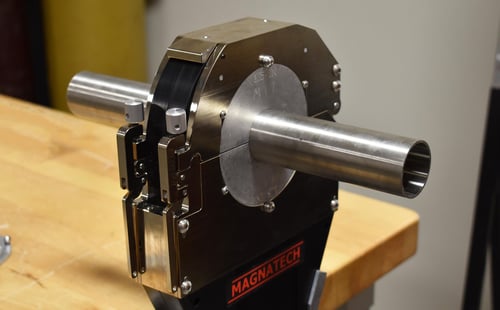The arc weld gap is one of the most important factors in successful orbital welding, but it’s also one of the most misunderstood. An arc weld gap, also known as an electrode stick out or simply stick out, refers to the distance from the tungsten tip to the workpiece—the farther away it is, the larger the arc gap will be. Having too large arc gaps can cause incomplete welds and lead to burn through, while small arc gaps are more likely to lead to porosity, particularly if you’re using too much current. We're exploring the differences in arc gap distances, how they affect welds, and what gaps work best for specific applications.
What is an Arc Gap?
There are 2 distinct types of arc gaps, those made by Alternating Currents (AC) and Direct Currents (DC). Arc gaps that made using AC are produced when two conductors are touched together and then separated by a small gap, typically around 2 - 4mm. This gap will produce energy in the form of electrons, this is where you get the name electrode as it's an electrical conductor. When these electrons arc from the electrode to the workpiece, a weld is created, and it goes back to the original location. The other way for an arc gap to be created is through a DC circuit, with one end being positive and the other negative. If there isn't a ground between them, then it will create an arc and continue moving until everything around it has been consumed in flames. TIG welding (specifically orbital welding) uses the AC method to create an arc in a contained environment, a weld head, and on a workpiece purged with Argon.

Arc Gap Distances
Arc weld gap distances are vitally important for the process of welding. It is crucial to consider the functions of each arc gap size before choosing what to use on any given job.
In general, there are two main categories: electric currents which are generally low voltage AC; and gas currents, which typically take higher voltage DC circuits. The different sized arcs usually correspond with these differences in current strength as well as other factors such as the type of electrode material you will be welding with, material thicknesses, and desired weld penetration depth.
The orbital weld heads MIT distributes from AMI and Magnatech typically use 3 main gap lengths depending on three major factors.
- Weld Head: Depending on the weld head, the arc gap may be narrower or wider. The speed of the rotation of the weld head around the workpiece and the amperage are the two biggest factors to consider.
- Tungsten: The tungsten length is the most important factor in determining the arc gap. Because the length, finish, and head of the tungsten are different than traditional tungsten, ensuring your calculations are
- Workpiece Material: Depending on the material used (Stainless Steel, Copper, Aluminum, Carbon Steel etc.) the amperage and arc gap will vary drastically.
Arc Gaps Examples
The three most used arc gaps for orbital welding are .030”, .050”, and .070”.
.030: Used in small O.D. and thin wall sanitary applications
.050: Used in majority of applications like .065” sanitary tubing
.070: Used in large O.D. and heavier wall sanitary applications.
Sample Size Table
-png.png)
Sample Size Table
Oct 4, 2022 12:44:07 PM

.png)
Comments